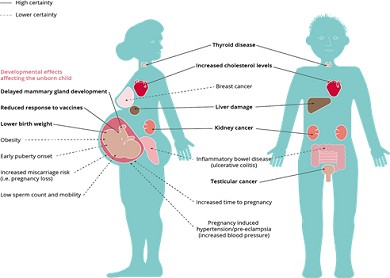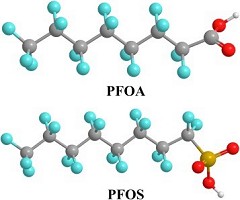What are PFAS?
Perfluoroalkyl and Polyfluoroalkyl Substances, or PFAS, is an umbrella term for over 8,000 man-made chemicals characterized by multiple fluorine atoms attached to an alkyl chain. Being fully fluorinated makes these chemicals extremely hard to break down. Such strong chemical bonds give it commercial value for products requiring resistance to heat, stains, water, and grease. PFAS manufacturing began in the 1940s and was found to be so useful that these chemicals can be found in almost all household items considered non-stick, non-stain, oil-resistant, or water-resistant. The Center for Disease Control has stated on their website that nearly everyone residing in the US has PFAS in their body. Dubbed by many as "forever chemicals" since they do not readily break down, PFAS accumulate in the environment, especially in soils, surface waters, and animals.

Commercial manufacturing of PFAS began in the 1940s, and industry has expanded production ever since. Since 2010, many PFAS chemicals have been voluntarily phased out by eight US chemical companies, but PFAS are still widely found due to its legacy of use and persistence in the environment. New "short-chain" and Gen-X fluorinated compounds have replaced, or are replacing, the older ones.
What are the health concerns?
Dr. Linda Birnbaum, former director of the National Institute for Environmental Health Sciences, argues that even minute amounts of PFAS are health concerns and that newer compounds act very similarly on lab rats. Therefore the whole class of PFAS should be regulated as one. (Watch the Maryland Public Interest Research Group's November 16, 2020 panel discussion on PFAS in Maryland.
“If you look at the data, pancreatic tumors are present at very, very low concentrations from PFOA [in rats],” Birnbaum told the audience at the conference. “If you use the pancreatic tumors in the rats in the [National Institute for Environmental Health Science National Toxicology Program] study to calculate what would really be a virtually safe dose, you’re getting down at about 0.1 ppt. [parts per trillion] Well, that’s really low. And that’s only for one PFAS.”
Dr. Birnbaum was speaking about many, if not all, of the PFAS family of chemicals. Studies in lab rats found similar health responses to the newer "short chain" and GenX chemicals at extremely low doses as they had with PFOA and PFOS. It's important to understand that these chemicals accumulate in our bodies and the health impact is likely the sum total of all of them.
PFAS are associated with suppressed immune function, thyroid disease, testicular and kidney disease, cancers, and liver damage. Newer short chain and GenX compounds have been studied little but scientists studying them currently are finding that they have similar toxicology to long chain PFAS.
Other recent studies have associated PFOS and PFOA with hepatotoxicity, neurotoxicity, reproductive toxicity, immunotoxicity, thyroid disruption, cardiovascular toxicity, pulmonary toxicity, and renal toxicity in laboratory animals and suggest these conditions may affect in-vitro human systems.

PFAS effect on human health published by the European Environment Agency. Retrieved from: https://www.eea.europa.eu/themes/human/chemicals/emerging-chemical-risks-in-europe
What's in St. Mary's River?
The St. Mary's River Watershed Association (SMRWA), the Maryland Department of the Environment, and the Public Employees for Environmental Responsibility have all tested the waters of the St. Mary's River for PFAS. All three also tested oysters; PEER also tested a blue crab and a Rockfish caught nearby in Cornfield Harbor. All three studies had similar findings for the waters of the St. Mary's River—minute quantities of PFAS were in most locations tested. Several compounds were found in some areas. Total PFAS ranged from 1.1 ppt to 13.7 ppt. The focus of all three groups' testing was the Navy's Webster Outlying Field as a potential source or hotspot. But testing done further upriver, at the mouth of the Patuxent, and near Maryland's eastern shore (Fishing Bay was 6.79 ppt to 12.47 ppt) also detected PFAS.
Oysters tested by SMRWA and PEER and the one crab had detectible total PFAS of similar range. The highest oyster was 2070 ppt of five PFAS compounds and the crab had 6,650 ppt of eight PFAS compounds. By far the 23-inch Rockfish, which is believed to have been three years old, had the highest concentration of PFAS compounds at 23,100 ppt. The lab that MDE used for analysis was unable to detect any PFAS in oysters; their detection level was 1000 times higher than the other labs that SMRWA and PEER contracted.
Studies elsewhere, such as New Jersey, New Hampshire, and North Carolina, have had similar results comparing fish and oysters. Generally, it appears that fish have about ten or more times as much PFAS as oysters.

Suspected release and flow of PFAS contamination on the Patuxent Navy Base that was presented at a public meeting hosted by the US Navy on March 3, 2020 at the Lexington Park Library. SMRWA file photo of a US Navy poster.



